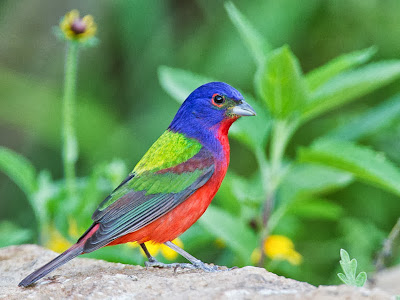The Painted Bunting (Passerina ciris) is a species of bird in the Cardinal family, Cardinalidae, that is native to North America.
Painted Buntings are mostly monogamous and are solitary or in pairs during the breeding season, but sometimes exhibit polygyny. The breeding season begins in late April and lasts through to early August, with activity peaking mid-May through to mid-July. The male arrives about a week before the female and starts to establish a small territory. The nest is typically hidden in low, dense vegetation and is built by the females and woven into the surrounding vegetation for strength.[6] Each brood contains 3 or 4 gray-white eggs, often spotted with brown, which are incubated for around 10 days until the altricial young are hatched. The female alone cares for the young. The hatchlings are brooded for approximately 12 to 14 days and then fledge at that time. About 30 days after the first eggs hatch, the female Painted Bunting usually lays a second brood.[6] Nests are often parasitized by cowbirds.Common predators at the nest of eggs, young, and brooding females are large snakes, including Coachwhip Snakes, Eastern Kingsnakes, Eastern Racers, and Black Rat Snakes.[6] Bird-hunting raptors, including Short-tailed Hawks, Accipiter hawks, and even the small passerine the Loggerhead Shrike, may hunt Painted Buntings, including the conspicuous breeding-plumaged male. The Painted Bunting can live to over 10 years of age, though most wild buntings probably live barely half that long.
The male Painted Bunting is often described as the most beautiful bird in North America. Its colors, dark blue head, green back, red rump, and underparts, make it extremely easy to identify, but it can still be difficult to spot since it often skulks in foliage even when it is singing. The plumage of female and juvenile Painted Buntings is green and yellow-green, serving as camouflage. Once seen, the adult female is still distinctive, since it is one of the only truly green birds native to the United States. Adult painted buntings can measure 12–14 cm (4.7–5.5 in) in length, span 21–23 cm (8.3–9.1 in) across the wings and weigh 13–19 g (0.46–0.67 oz).
Distribution and habitat
The Painted Bunting occupies typical habitat for a member of its family. It is found in thickets, woodland edges with riparian thickets, shrubbery and brushy areas. In the East, the species breeds in maritime hammocks and scrub communities. Today, it is often found along roadsides and in suburban areas, and in gardens with dense, shrubby vegetation. The wintering habitat is typically the shrubby edges along the border of tropical forests or densely-vegetated savanna.The breeding range includes southern Arizona, southern New Mexico, southern and eastern Texas, Oklahoma, Arkansas, Louisiana, northern Florida, coastal Georgia, the southern coast of South Carolina, and northern Mexico.They winter in South Florida, Cuba, the Bahamas, along both coasts of Mexico and through much of Central America. Occasionally, they may vagrate further north outside of their normal range, including to New York,Pennsylvania and New Jersey.
Painted Buntings often feed by hopping along the ground, cautiously stopping every few moments to look around. The Painted Bunting regularly eats a large quantity of grass seeds, including Panicum, Amaranthus, Oxalis, Euphorbia, and Carex. Seeds are eaten almost exclusively during winter. While breeding, Painted Bunting and nestlings mainly eat small invertebrates, including spiders, snails, grasshoppers, caterpillars, and other insects. They have been known to regularly visit spider webs to pick off small insects caught in them.
Data refer : http://en.wikipedia.org/wiki/Painted_Bunting





